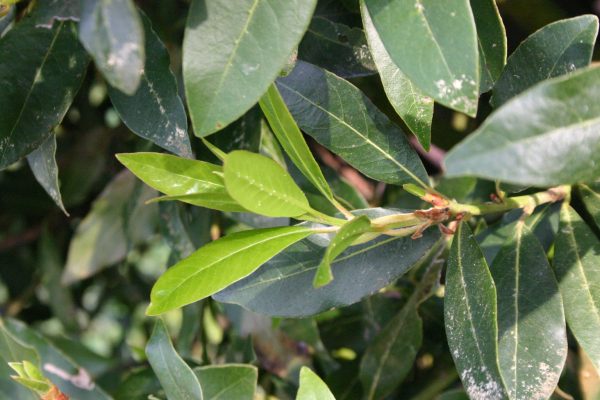Pollination – Further Explorations

A couple of weeks ago I wrote about the “Pollinator-Friendly” Plant Sale at the Dunwoody Nature Center (770-394 3322). A recent radio caller wanted even more information on pollination. He queried, “I understand perfect flowered plants (both sexes in one flower), monoecious plants (male and female flowers on same plant), and dioecious plants (one sex per plant). So what kind of flowers do blueberries have if they need cross-pollination to set fruit but they are not dioecious?”
We’ll pause here a minute while you read the previous paragraph again. Don’t let the concepts intimidate you; they are necessary for the following expiation.
The caller described the pollination situation correctly. Some plants have perfect flowers, some have separate male and female flowers on the same plant and some have male and female flowers on different plants.
So his question is a good, basic interrogatory. Why indeed do apples, blueberries, plums and other fruits need another variety nearby in order to bear many fruit?
According to University of Georgia horticulturist Mark Rieger, plants have evolved various strategies to insure their success. One of the best schemes is to reject pollen that comes from your own flowers and to favor pollen from strangers. This keeps the population broader genetically, ready for challenges brought on by climate change, new pests, etc. It doesn’t mean a blueberry can be pollinated by a peach but it does help insure a species’ survival.
Fruit growers have observed for hundreds of years that blueberries, apples and plums bear much more fruit if a different variety is planted within fifty feet. Bees transfer pollen between the varieties efficiently and the gardener gets bragging rights over how much fruit they harvest.
That said, some fruits are completely self-compatible and require nothing more than their own pollen to set fruit. Confusing, huh? Since I know fruit plants are arriving daily at local nurseries, the accompanying list provides guidelines for when single or multiple varieties are required.
HOLLY POLLINATION I spoke at a training meeting for nursery personnel a few weeks ago and was inundated with questions about how hollies pollinate. The folks knew that hollies have male and female plants, and that only the females bear berries. They wondered, though, if there must be a male pollinator for every species of holly in a landscape.
Most hollies, whether evergreen or bare in winter, require a male holly to provide pollen to insure fruit set. In some cases it doesn’t have to be pollen from the same species. Though a couple of hollies set fruit in the absence of a male, the resulting berries have sterile seeds. Here again, the accompanying chart gives holly pollination basics.
Speaking as the father of a twelve-year old, let me attest that conversations about plant procreation are much easier than those about human breeding. The multitude of plants flowering during the next months should give you plenty of opportunities to bring up a subject that is vitally important to gardeners and to parents!
HOLLY POLLINATION
American holly (Ilex opaca) grows wild in the woods near most homes so male pollen should be available if you have greenspace nearby. ‘Jersey Knight’ brings the required male presence if you have no hollies within a quarter mile.
English holly (I. aquifolium) usually gets enough pollen from American holly but ‘Gold Coast’ is a male form.
Winterberry holly (I.. verticillata) requires a male plant to bear noticeable numbers of fruit. ‘Apollo’, ‘Raritan Chief’, ‘Jim Dandy’ and ‘Southern Gentleman’ are consorts readily available at nurseries that sell the female holly varieties.
‘Foster’ holly (Ilex x attenuata ‘Fosteri’) typically gets enough pollen from nearby American hollies but ‘Foster #4′ is a male plant.
Possumhaw holly (I. decidua) is usually pollinated by American holly; ‘Red Escort’ is a male form.
‘Burford’ holly (I. cornuta ‘Burfordii’) is parthenocarpic. It sets seed without requiring a pollinator.
‘Nellie R. Stevens’ (Ilex x ‘Nellie R. Stevens’) is partially parthenocarpic. Better fruit set occurs when it is pollinated by a close-at-hand Ilex x ‘Edward J. Stevens’
Yaupon holly (I. vomitoria) – seems to get enough pollen from unknown sources to have nice berries most years. ‘Will Fleming’ is a male plant.
FRUIT POLLINATION
Follow these general pollination guidelines when deciding whether you need one or more varieties of each fruit:
Apple– plant at least two different varieties
Banana– self-fruitful
Blueberry– plant at least two different varieties
Cherry, Pie– self-fruitful
Cherry, Sweet– plant at least two different varieties
Fig– self-fruitful
Grape, Bunch– self-fruitful
Grape, Muscadine– plant at least two different varieties, one must be self-fruitful
Kiwifruit– must have male plant nearby
Mayhaw– self-fruitful
Mulberry– self-fruitful
Pawpaw– planting two or more improves fruit set
Peach– self-fruitful
Pear– most are self-fruitful
Persimmon– American persimmons must have one male tree nearby, some Asian varieties are self-pollinating
Plum– plant at least two different varieties
Pomegranate– planting two or more improves fruit set
Quince– self-fruitful
Raspberry, blackberry– self-fruitful
Strawberry– self-fruitful














